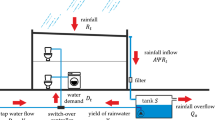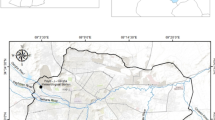Abstract
The urban-scale impacts of the use of Rainwater Harvesting Systems (RWHS) are little explored within the Brazilian urban and climatic reality. Thus, the objective of this work is to verify the impacts of these systems in reducing runoff and the demand for drinking water, through a case study carried out in a neighborhood in the city of Goiânia-GO. In order to carry out the study, the land use characteristics of the studied region were studied from satellite images, with three batch patterns being defined as study scenarios. The daily residential demand for non-drinking uses of water was calculated from the standard lots and the annual rainfall pattern in the city of Goiânia, which was also characterized by taking a 30-year historical series of daily rainfall data. With these data in hand, daily water balances were calculated using Excel, for commercial reservoirs of 1, 5 and 10 m3, in addition to reservoirs with ideal volumes obtained from the NETUNO software. Two balance models were tested and compared and, from them, analyzes were made of the potential for reducing the annual consumption of drinking water in the neighborhood and hydrological simulations were run to verify the flow damping, with the support of the SWMM program. In general, the RWHS use has positive aspects: it reduces the drinking water demand in the neighborhood (up to 37%). However, when analyzing the reduction of peak flows in the drainage system, it is only significant in scenarios with larger reservoirs, confirming its marginal role in stormwater management.




Similar content being viewed by others
Availability of Data and Material
Not applicable.
Code Availability
Not applicable.
References
Associação Brasileira De Normas Técnicas (2019) ABNT NBR 15527 - Águas de chuva - Aproveitamento de coberturas em áreas urbanas para fins não potáveis - Requisitos Brasil (in Portuguese)
AUTODESK (2018) AutoCAD. Disponível em: https://www.autodesk.com.br/products/autocad/free-trial
BRASIL. AGÊNCIA NACIONAL DE ÁGUAS - ANA (2019) Abastecimento Urbano de Água. Available in: http://atlas.ana.gov.br/Atlas/forms/analise/Geral.aspx?est=12&mapa=diag. Access on: fev. 8 (in Portuguese)
Campisano A, Lupia F (2017) A dimensionless approach for the urban-scale evaluation of domestic rainwater harvesting systems for toilet flushing and garden irrigation. Urban Water Journal 14(9):883–891
Campos M, Pacheco G (2016) Economical criteria to size rainwater harvesting tanks : How the rainfall data can interfere ? 41ST IAHS World Congress
Carvalho ETL (2013) Avaliação Geotécnica de Poços de Infiltração de Águas Pluviais. [s.l.] Universidade de Brasília (in Portuguese)
Costa AR, de Siqueira EQ, de Menezes Filho FCM (2007) Curso Básico de hidrologia Urbana: nível 3. ReCESA ed. Brasília: ReCESA (in Portuguese)
Dornelles F (2012) Aproveitamento de Água de Chuva no Meio Urbano e seu Efeito na Drenagem Pluvial. [s.l.]. PhD Tesis at Post-Graduate Program in Water Resources Engineering and Environmental Sanitation at Federal University of Rio Grande do Sul. Available in: https://www.lume.ufrgs.br/bitstream/handle/10183/55968/000851396.pdf?sequence=1. Access on: nov. 22 (in Portuguese)
EPA - United States Environmental Protection Agency (2018) Storm Water Management Model (SWMM). Disponível em: https://www.epa.gov/water-research/storm-water-management-model-swmm. Acesso em: 2 maio (in Portuguese)
Farooq S, Mahmood K, Faizi F (2022) Comparative simulation of GIS-based rainwater management solutions. Water Resour Manage 36(9):3049–3065
Fernandes S, Bonfante MC, de Oliveira CT et al (2020) Decentralized water supply management model: a case study of public policies for the utilization of rainwater. Water Resour Manage 34(9):2771–2785
Ghisi E, Cordova M (2014) Netuno 4.Santa CatarinaUniversidade Federal de Santa Catarina, Departamento de Engenharia Civil. Disponível em: http://www.labeee.ufsc.br/%0A
GOOGLE (2018) Google Earth Pro
Herrmann T, Schmida U (2000) Rainwater utilisation in Germany: efficiency, dimensioning, hydraulic and environmental aspects. Urban Water 1(4):307–316
Hu M et al (2017) Evaluation of low impact development approach for mitigating flood inundation at a watershed scale in China. J Environ Manage 193:430–438
IBGE - Instituto Brasileiro de Geografia e Estatística (2017a) Valor do rendimento nominal mediano mensal dos domicílios particulares permanentes, com rendimento domiciliar – Total. Available in: https://censo2010.ibge.gov.br/apps/areaponderacao/. Access on: fev. 15 (in Portuguese)
IBGE - Instituto Brasileiro de Geografia e Estatística (2017b) Censo Demográfico. Available in: https://censo2010.ibge.gov.br. Access on: fev. 5 (in Portuguese)
INMET - Instituto Nacional De Meteorologia (2018) Estação Meteorológica de Observação de Superfície Automática. Disponível em: http://www.inmet.gov.br/portal/index.php?r=estacoes/estacoesAutomaticas
Jenkins GA, Greenway M, Polson C (2012) The impact of water reuse on the hydrology and ecology of a constructed stormwater wetland and its catchment. Ecol Eng 47:308–315
Jing X et al (2017) Assessing efficiency and economic viability of rainwater harvesting systems for meeting non-potable water demands in four climatic zones of China. Resour Conserv Recycl 126:74–85
Jing X, Zhang S, Zhang J et al (2018) Analysis and modelling of stormwater volume control performance of rainwater harvesting systems in four climatic zones of China. Water Resour Manage 32(8):2649–2664
Kim H, Han M, Lee JY (2012) The application of an analytical probabilistic model for estimating the rainfall-runoff reductions achieved using a rainwater harvesting system. Sci Total Environ 424:213–218
Pauleit S, Duhme F (2000) Assessing the environmental performance of land cover types for urban planning. Landsc Urban Plan 52(1):1–20
QGIS 2.18 (2017) Disponível em: https://qgis.org/pt_BR/site/forusers/index.html#
Rego TL, Barros JR (2014) Alagamentos E Inundações Em Goiânia: Uma Análise A Partir Da Imprensa Local E Dos Registros Da Defesa Civil1. Revista Formação 1:170–185
Rossman LA (2010) Stormwater management model user’s manual. Version 5.0
Rostad N, Foti R, Montalto FA (2016) Harvesting rooftop runoff to flush toilets: Drawing conclusions from four major U.S. cities. Resour Conserv Recycl 108:97–106
SEPLAN (1980) Partido Urbanístico Parque AtheneuGoiâniaEngenharia Comércio e Indústria - Encol SA
SEPLAN (2015) Mapa Urbano Básico Digital de Goiânia - MUBDG v.25.Goiânia. Disponível em: https://drive.google.com/drive/folders/0BxaZzRkwABUafjJXbEpKal9CVFlYeEhyOEFtTHVuTWhkalVaWkU3ajdIOElYQmhLMHdrcDQ. Accessed 20 Aug 2001
Snir O, Friedler E (2021) Dual benefit of rainwater harvesting—high temporal-resolution stochastic modelling. Water 13(17):2415
Steffen J et al (2013) Water supply and stormwater management benefits of residential rainwater harvesting in U.S. cities. J Am Water Resour Assoc 49(4):810–824
Walsh TC, Pomeroy CA, Burian SJ (2014) Hydrologic modeling analysis of a passive, residential rainwater harvesting program in an urbanized, semi-arid watershed. J Hydrol 508:240–253
York C, Goharian E, Burian SJ (2015) Impacts of large-scale stormwater green infrastructure implementation and climate variability on receiving water response in the Salt Lake City Area. Am J Environ Sci 11(4):278–292
Acknowledgements
The authors wish to express their gratitude to the Coordination for the Improvement of Higher Education Personnel (CAPES) Foundation for the master research scholarship.
Funding
Funding for this study was provided by the Federal Government of Brazil through the Coordination for the Improvement of Higher Education Personnel (CAPES) Foundation for the master research scholarship.
Author information
Authors and Affiliations
Contributions
Msc. Sara Lopes Souto - Data Collection Researcher and Manuscript Writer. Dr. Ricardo Prado A. Reis - Manuscript Writer and Reviewer Researcher and Research Advisor. Dr. Marcus André Siqueira Campos - Outline of Conceptual Framework, Manuscript Writer, Reviewer Researcher and Research Advisor.
Corresponding author
Ethics declarations
Ethics Approval
Not applicable.
Consent to Participate
All authors consent to participate.
Consent for Publication
All authors consent for publications.
Conflicts of Interest/Competing Interests
The authors declare that there is no conflict of interest.
Additional information
Publisher's Note
Springer Nature remains neutral with regard to jurisdictional claims in published maps and institutional affiliations.
Supplementary Information
Below is the link to the electronic supplementary material.
Rights and permissions
Springer Nature or its licensor (e.g. a society or other partner) holds exclusive rights to this article under a publishing agreement with the author(s) or other rightsholder(s); author self-archiving of the accepted manuscript version of this article is solely governed by the terms of such publishing agreement and applicable law.
About this article
Cite this article
Souto, S.L., Reis, R.P.A. & Campos, M.A.S. Impact of Installing Rainwater Harvesting System on Urban Water Management. Water Resour Manage 37, 583–600 (2023). https://doi.org/10.1007/s11269-022-03374-z
Received:
Accepted:
Published:
Issue Date:
DOI: https://doi.org/10.1007/s11269-022-03374-z




